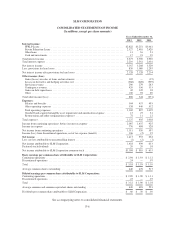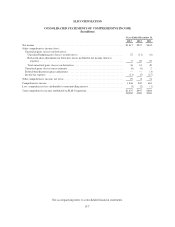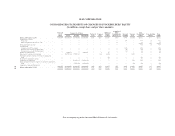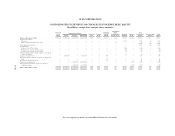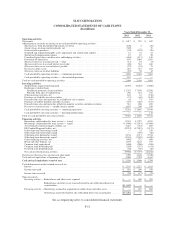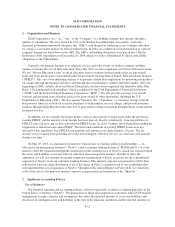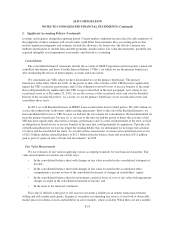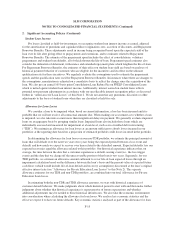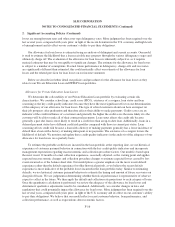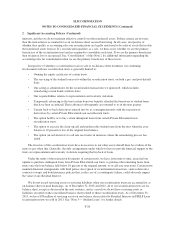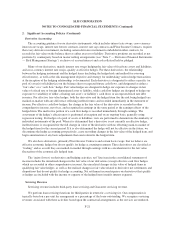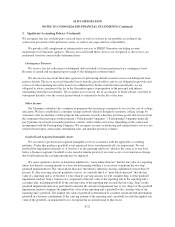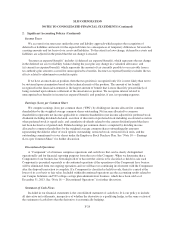Sallie Mae 2013 Annual Report Download - page 153
Download and view the complete annual report
Please find page 153 of the 2013 Sallie Mae annual report below. You can navigate through the pages in the report by either clicking on the pages listed below, or by using the keyword search tool below to find specific information within the annual report.SLM CORPORATION
NOTES TO CONSOLIDATED FINANCIAL STATEMENTS (Continued)
2. Significant Accounting Policies (Continued)
Student Loan Income
For loans classified as held-for-investment, we recognize student loan interest income as earned, adjusted
for the amortization of premiums and capitalized direct origination costs, accretion of discounts, and Repayment
Borrower Benefits. These adjustments result in income being recognized based upon the expected yield of the
loan over its life after giving effect to prepayments and extensions, and to estimates related to Repayment
Borrower Benefits. The estimate of the prepayment speed includes the effect of consolidations, voluntary
prepayments and student loan defaults, all of which shorten the life-of-loan. Prepayment speed estimates also
consider the utilization of deferment, forbearance and extended repayment plans which lengthen the life-of-loan.
For Repayment Borrower Benefits, the estimates of their effect on student loan yield are based on analyses of
historical payment behavior of customers who are eligible for the incentives and its effect on the ultimate
qualification rate for these incentives. We regularly evaluate the assumptions used to estimate the prepayment
speeds and the qualification rates used for Repayment Borrower Benefits. In instances where there are changes to
the assumptions, amortization is adjusted on a cumulative basis to reflect the change since the acquisition of the
loan. We also pay an annual 105 basis point Consolidation Loan Rebate Fee on FFELP Consolidation Loans
which is netted against student loan interest income. Additionally, interest earned on student loans reflects
potential non-payment adjustments in accordance with our uncollectible interest recognition policy as discussed
further in “Allowance for Loan Losses” of this Note 2. We do not amortize any premiums, discounts or other
adjustments to the basis of student loans when they are classified as held-for-sale.
Allowance for Loan Losses
We consider a loan to be impaired when, based on current information, a loss has been incurred and it is
probable that we will not receive all contractual amounts due. When making our assessment as to whether a loan
is impaired, we also take into account more than insignificant delays in payment. We generally evaluate impaired
loans on an aggregate basis by grouping similar loans. Impaired loans also include those loans which are
individually assessed and measured for impairment at a loan level, such as in a troubled debt restructuring
(“TDR”). We maintain an allowance for loan losses at an amount sufficient to absorb losses incurred in our
portfolios at the reporting date based on a projection of estimated probable credit losses incurred in the portfolio.
In determining the allowance for loan losses on our non-TDR portfolio, we estimate the principal amount of
loans that will default over the next two years (two years being the expected period between a loss event and
default) and how much we expect to recover over time related to the defaulted amount. Expected defaults less our
expected recoveries equal the allowance related to this portfolio. Our historical experience indicates that, on
average, the time between the date that a customer experiences a default causing event (i.e., the loss trigger
event) and the date that we charge off the unrecoverable portion of that loan is two years. Separately, for our
TDR portfolio, we estimate an allowance amount sufficient to cover life-of-loan expected losses through an
impairment calculation based on the difference between the loan’s basis and the present value of expected future
cash flows (which would include life-of-loan default and recovery assumptions) discounted at the loan’s original
effective interest rate (see “Allowance for Private Education Loan Losses” to this Note 2). The separate
allowance estimates for our TDR and non-TDR portfolios, are combined into our total Allowance for Private
Education Loan losses.
In estimating both the non-TDR and TDR allowance amounts, we start with historical experience of
customer default behavior. We make judgments about which historical period to start with and then make further
judgments about whether that historical experience is representative of future expectations and whether
additional adjustments may be needed to those historical default rates. We also take the economic environment
into consideration when calculating the allowance for loan losses. We analyze key economic statistics and the
effect we expect it to have on future defaults. Key economic statistics analyzed as part of the allowance for loan
F-15



